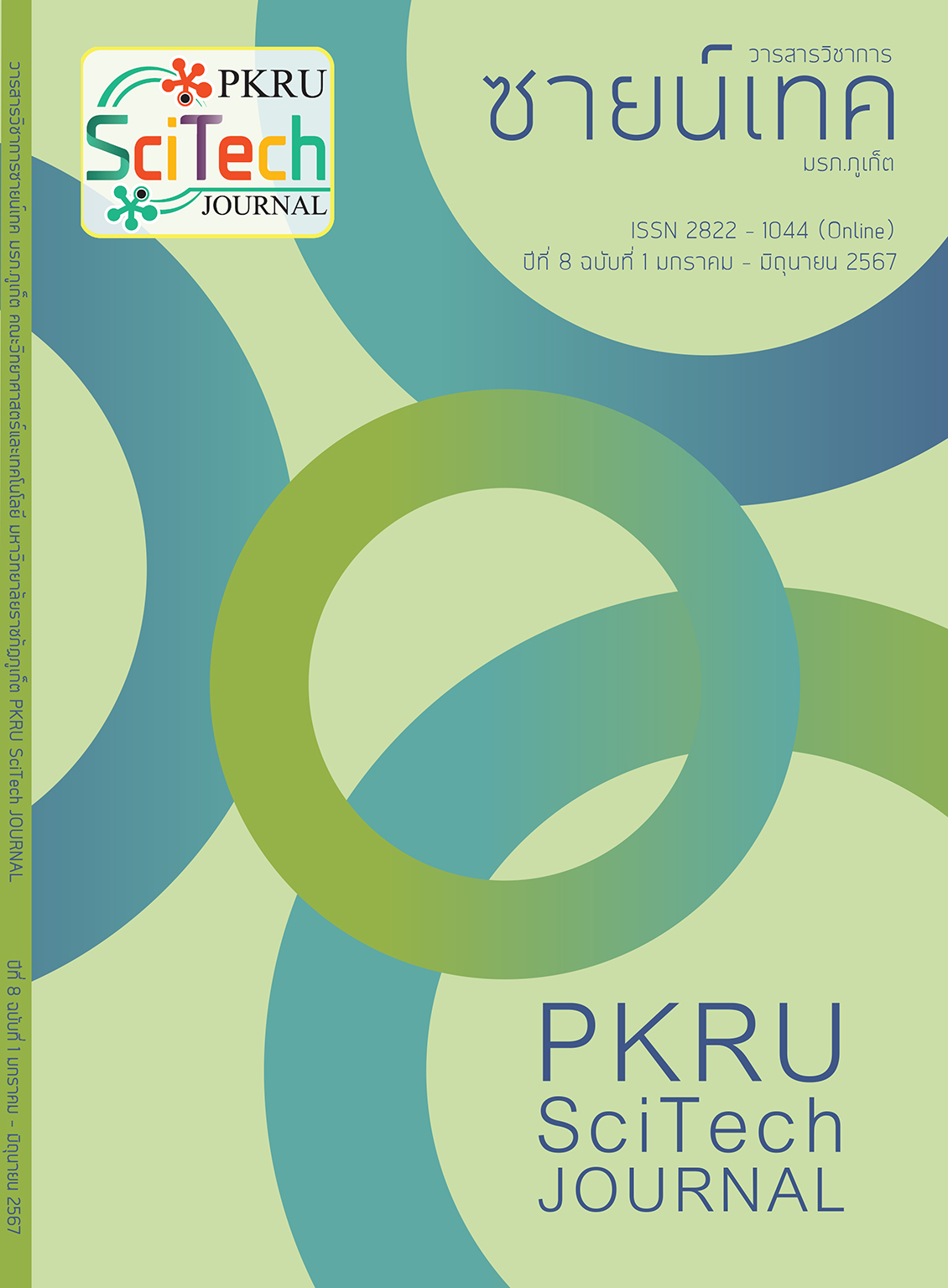แบบจำลองการจำแนกรูปภาพตามความหมาย ได้รับการฝึกฝนสำหรับการเรียกค้นรูปภาพโดยใช้ภาษาธรรมชาติ
Main Article Content
บทคัดย่อ
งานวิจัยนี้มีวัตถุประสงค์เพื่อพัฒนาแบบจำลองการจำแนกรูปภาพตามความหมายโดยใช้ตัวแบบที่ถูกฝึกฝนล่วงหน้าแบบคอนทราสต์ด้วยข้อความและรูปภาพ และเรียนรู้ซ้ำบนชุดข้อมูลที่กำหนดเอง ผลการประเมินตัวแบบที่ได้รับการฝึกฝนสำหรับการเรียกค้นรูปภาพโดยใช้ภาษาธรรมชาติ เปรียบเทียบระหว่างผลการพยากรณ์ป้ายกำกับภาษาธรรมชาติกับผลการประเมินความหมายของป้ายกำกับจากผู้เชี่ยวชาญ พบว่า ผลการพยากรณ์ป้ายกำกับภาษาธรรมชาติภายใต้ 3 เงื่อนไข ได้แก่ 1) ข้อความบรรยายรูปภาพ ในลักษณะป้ายกำกับของรูปภาพ 2) ข้อความบรรยายรูปภาพเกี่ยวกับแนวคิดระดับสูงของภาพ และ 3) ข้อความบรรยายรูปภาพที่อธิบายความหมายเชิงคุณภาพของรูปภาพเท่ากับ 0.905, 0.830 และ 0.585 ตามลำดับ โดยผลการประเมินด้วยข้อความบรรยายรูปภาพที่อธิบายความหมายเชิงคุณภาพของรูปภาพอยู่ในระดับปานกลาง เนื่องจากข้อความที่อยู่ในรูปแบบของป้ายกำกับภาษาธรรมชาตินั้นถือว่าเป็นแนวคิดระดับสูง ดังนั้นประสบการณ์ของแต่ละบุคคลจึงส่งผลให้การประเมินนั้นแตกต่างกันตามหลักการรับรู้ของมนุษย์ อันจะเห็นได้จากผลการพยากรณ์ที่ใกล้เคียงกันของข้อความบรรยายรูปภาพที่มากกว่า 1 ตัวเลือก การเรียกค้นรูปภาพตามความหมายจึงควรให้ความสำคัญกับการลดช่องว่างความหมายของคำค้นหา และช่วยสนับสนุนผู้ใช้ด้วยการใช้คำค้นภายใต้รูปแบบของภาษาธรรมชาติที่ยึดโยงกับความหมายของรูปภาพแทนที่จะยึดตามหลักไวยากรณ์ของภาษา อันจะเป็นแนวทางการเรียกคืนสารสนเทศในอนาคต
Article Details

อนุญาตภายใต้เงื่อนไข Creative Commons Attribution-NonCommercial-NoDerivatives 4.0 International License.
- เนื้อหาต้นฉบับที่ปรากฏในวารสารเป็นความรับผิดชอบของผู้เขียน ทั้งนี้ไม่รวมความผิดพลาดอันเกิดจากเทคนิคการพิมพ์
- ลิขสิทธิ์ต้นฉบับที่ได้รับการตีพิมพ์ในวารสารวิชาการ ซายน์เทค มรภ.ภูเก็ต ถือเป็นกรรมสิทธิ์ของวารสารวิชาการ ซายน์เทค มรภ.ภูเก็ต
เอกสารอ้างอิง
Tyagi, V. (2017). Content-Based Image Retrieval Ideas, Influences, and Current Trends. Gateway East: Springer.
Barz, B., & Denzler, J. (2020). Content-based Image Retrieval and the Semantic Gap in the Deep Learning Era (pp 2 - 19). In International Workshop on Content-Based Image Retrieval: where have we been, and where are we going (CBIR 2020). Italy.
Aggarwal, C. C. (2018). Neural Networks and Deep Learning: A Textbook. Cham: Springer.
LeCun, Y., Bottou, L., Bengio, Y., & Haffner, P. (1998).Gradient-based learning applied to document recognition (pp 2278-2324). In Proceedings of the IEEE. USA.
Goodfellow, I., Bengio, Y., & Courville, A. (2016). Deep Learning. Massachusetts: MIT Press.
He, K., Zhang, X., Ren, S., & Sun, J. (2016). Deep Residual Learning for Image Recognition (pp 770-778). In 2016 IEEE Conference on Computer Vision and Pattern Recognition (CVPR). USA.
Vaswani, A., Shazeer, N., Parmar, N., Uszkoreit, J., Jones, L., Gomez, A., Kaiser, L., & Polosukhin, I. Attention Is All You Need (pp 6000-6010). In 31st Conference on Neural Information Processing Systems (NIPS 2017). USA.
Dosovitskiy, A., Beyer, L., Kolesnikov, A., Weissenborn, D., Zhai, X., Unterthiner, T., Dehghani, M., Minderer, M., Heigold, G., Gelly, S., Uszkoreit, J., & Houlsby, N. (2021). An Image is Worth 16x16 Words: Transformers for Image Recognition at Scale (pp 1-21). In 9th International Conference on Learning Representations 2021 (ICLR 2021). Austria.
Radford, A., Kim, J. W., Hallacy, C., Ramesh, A., Goh, G., Agarwal, S., Sastry, G., Askell, A., Mishkin, P., Clark, J., Krueger, G., & Sutskever, I. (2021). Learning Transferable Visual Models From Natural Language Supervision (pp 8748-8763). In 38th International Conference on Machine Learning (ICML 2021).
Xu, M., Yoon, S., Fuentes, A., & Park, D. S. (2023). A Comprehensive Survey of Image Augmentation Techniques for Deep Learning. Pattern Recognition, 137, 109347.
Sanh, V., Debut, L., Chaumond, J., & Wolf, T. (2019). DistilBERT, a distilled version of BERT: smaller, faster, cheaper and lighter. arXiv preprint arXiv: 1910.01108, 1-5.
Nwankpa, C., Ijomah, W., Gachagan, A., & Marshall, S. (2018). Activation Functions: Comparison of trends in Practice and Research for Deep Learning. arXiv preprint arXiv: 1910.01108, 1-20.
Rosebrock, A. (2017). Deep Learning for Computer Vision with Python. New York: PYIMAGESEARCH.
Sawarka, K. (2022). Deep Learning with PyTorch Lightning Swiftly build high-performance Artificial Intelligence (AI) models using Python. Birmingham: Packt.
Christian, B. (2011). The Most Human Human: What Talking with Computers Teaches Us About What It Means to Be Alive. New York: Doubleday.
อรนุช ศรีสะอาด. (2561). การตรวจสอบความเที่ยงตรงของเครื่องมือวัดผลโดยผู้เชี่ยวชาญ. วารสารการวัดผลการศึกษา มหาวิทยาลัยมหาสารคาม, 1(1), 45-49.
เรวัต แสงสุริยงค์. (2565). ความเสี่ยงของการเกิดความคลาดเคลื่อนในการวิจัยเชิงปริมาณด้านสังคมวิทยา. วารสารวิชาการมนุษยศาสตร์และสังคมศาสตร์ มหาวิทยาลัยบูรพา, 30(1), 158-185.
Brase, C. H., & Brase, C. P. (2018). Understanding Basic Statistics. Boston: Cengage Learning.
Benois-Pineau, J., & Zemmari, A. (2021). Multi-faceted Deep Learning: Models and Data. Cham: Springer.
Dix, A., Finlay, J., Abowd, G. D., & Beale, R. (2004). Human–Computer Interaction
(3rd edition). Harlow: Pearson.


